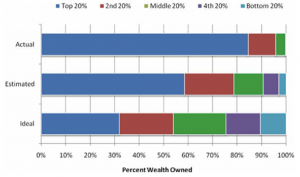Despite the vilification of the “1%”, occupation of financial centers like Wall Street and the visibly widening income gap, many Americans don’t actually know how severe the United States’ economic inequality is. In fact, those surveyed for Michael Norton’s (Harvard Business School) new study on public opinion of executive pay grossly underestimated the pay gap between the average worker and CEOs. According to the AFL-CIO, the average American worker makes about $34,000 a year, while the average CEO earns more than $12 million. For a better understanding of such a disparity, the average American worker makes about .28% of what the average executive makes. The actual ratio of CEO to worker pay reported was 354:1, while those surveyed estimated it was around 30:1. Those surveyed also believed the ratio should be around 7:1.
Norton conducted a similar study in 2011, where he asked a sample group of Americans to guess as to the actual wealth distribution in the United States and then show how they would ration the wealth in an “ideal” economy. Those assessed believed that about 59% of the country’s wealth was owned by the top 20%, when the top 20% of households actually constitute about 84% of American net worth. The “ideal” wealth distribution consisted of the top 20% owning only about 32% of the wealth and about 10% of the country’s wealth going to the 4th 20% and bottom 20%, respectively.
Despite these responses being gathered from a sample varying in age, income and political ideologies, Norton concluded there was a general consensus that the country’s wealth could be better distributed. Despite their differences, those surveyed agreed that economic inequality must be addressed. However, the wealth disparity between classes is nothing new. “Trickle-down” economics, raising the minimum wage and other economic strategies have been discussed for years. Some could work and some won’t. It comes down to politics, policies and taxes. The average American can have many opinions and suggestions regarding economic equality, but it’s apparent many are not willing to confront the short-term consequences: taxes for the rich, welfare programs, a higher minimum wage, etc.
However, there has been some debate about the disparity itself and what is to be expected in an economy as large as the United States’. When participants in Norton’s study were told to choose from three pie charts representing three separate economies: an unnamed economy with completely equal distribution, the United States, and Sweden, 92% of Americans surveyed chose Sweden. Sweden’s economy has an egalitarian distribution of wealth that resembles the study participants’ “ideal” distribution. The United States is not Sweden, so is such a change feasible or even reasonable? What’s fair and what’s not in regards to wealth distribution? What can (or should) be changed?

